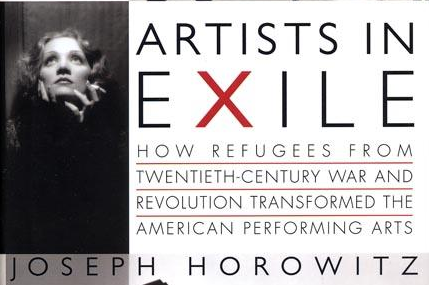Artists in Exile, by Joseph Horowitz
This is a terrific book, well written, thoroughly researched, full of anecdotes. If you’re interested in dance, you’ll enjoy the chapter on Balanchine. If you love classical music you’ll want to read about Stravinsky and Schoenberg. If you’re a film aficionado you’ll find a chapter devoted to Marlene Dietrich. If theater or Broadway shows are your main interest you can learn about the influence of Ruben Mamoulian. I can’t help but wonder whether the same reader would be equally interested in each section, and that’s my frustration with the book: I don’t have an equal interest in each of these areas. Mr. Horowitz presents each profiled artist (many more beyond the ones I named) as someone who profoundly affected today’s American cultural scene.
Joseph Horowitz is well known to classical musicians for his engaging books on such subjects as Toscanini, Dvořák, and “Wagner nights,” among others. His subject for this book (and its subtitle) “how refugees from 20th century war and revolution transformed the American performing arts” is one that has long needed a major reference book, and Mr. Horowitz has given us one.
I recently read and reviewed “Musicians from a Different Shore,” by Mari Yoshihara, and found it lacking in seriousness. No one could say that about Mr. Horowitz, since he tends to lean in the opposite direction. Take this sentence, found on p. 88: “In Germany, Serkin and Busch were a timely purifying influence in a protean cultural community diversified by a range of aesthetic dictates, and traumatized by political passions and socioeconomic chaos.” The reader has to read and re-read sentences like that one, but it’s part of the story about the founding of Marlboro – a huge influence on American musical life if ever there was one.
Or how about this one, on p. 121, concerning Hindemith’s Symphonic Metamorphosis: “The second movement, the theme of which is a Chinese tune adapted by a nineteenth-century German (who discovered it in an eighteenth-century French musical dictionary) unexpectedly interpolates a jazz fugue – a veritable jam session for brass, winds, and percussion (Hindemith even expected the players to stand) – as happy as his earliest jazz essays had been dour.”
No one disputes that the waves of immigrants who flooded America in the early 20th century had a profound impact on the cultural life of this country. Mr. Horowitz’s book shows in detail how the transformation happened, and how we are still being influenced by it. Horowitz goes one step further, arguing that not only did the immigrant artists change the face of America’s cultural scene, but those changes in turn have affected the arts on a world-wide scale.
I highly recommend this book for any artist, whether student or professional, who needs a reliable reference book on this topic.


No comments yet.
Add your comment